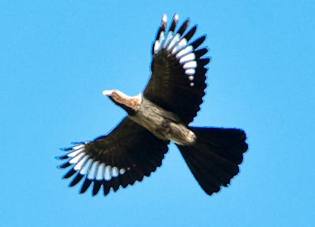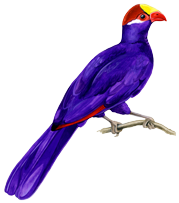 |
||
Birds of Farasuto Forest
All bird names used in this web site are from Barlow, C & Wacher, T (1997), “Birds of The Gambia and Senegal”, Helm (ISBN 0-7136-7549-7).
To submit bird or other records or notes about Farasuto please go here
The Farasuto bird list is from recollections not records. Members of the KBC, while being excellent birders, do not maintain ‘records’ (a record being a written note of a thing at a place on a date by a named person). In spite of repeated requests for a species list for Farasuto none was forthcoming through January to April so while there in April I forced the issue. At a KBC meeting on the edge of the reserve I went through, on my laptop, the entire Gambia bird list and accepted their joint views of which birds occur within or close to Farasuto’s forest and the list below is the result. I explained the significance and importance of records in some detail and left the KBC with Record Slips and they were to appoint Recorder. Additional records will be searched for among trip reports, on the www and in the literature at a later stage.
The Farasuto species list
The list is shown here and is a downloadable as an Excel97 spreadsheet.
The column to the right scores each species with a ‘1’ for those which have occurred at ‘Farasuto’, the forest and immediately surrounding area (a few 100m); 301 species. A few species have something in the ‘notes’ field.
Species in red and scored ‘N’ are those which I though might well occur, about which I asked the members of the KBC specifically and for which I received affirmation that they have not, in their knowledge, occurred.
Birds of Farasuto's forest
Species shaded out in green are Gambian costal forest obligates, that is species wholly confined, in the Western Division, to coastal forest patches which are believed, at the time of writing, to number 7; Abuko, Brufut Woods (part of), Cefo/Kite, Farasuto, Makasuto, Pirang/Bonto and Tanji. The known total of forest obligate bird species in The Gambia here totals 16 (there may be others – lists of them vary).
The Farasuto list flags up 17 costal forest obligates of which no fewer and 12 (71%) occur at Farasuto. This figure has to be a major plus for Farasuto and a reason for its conservation. The four forest obligates apparently absent from Farasuto are Square-tailed Drongo, Puvel’s Illadopsis, Green Hylia and Western Bluebill. I cannot imagine that any of these will have been overlooked by members of the KBC but they would certainly be worth looking out for in future. Green Crombec occur in Farasuto (they have gone from Abuko according to some reports) and efforts will be made during the coming rains to confirm the flufftail, last seen a few years ago. The total for all species seen within the forest at Farasuto (some on the top or edge, eg. cuckoos) is 96.
All bird and other records from Farasuto are welcomed at this web site. (see Contact LINK?).
February 2009
The Kuloro Bird Club were in the process of producing the first definitive list of birds recorded at Farasuto Community Nature Reserve, that is in the forest patch and also the adjoining woodland. This text is being written in advance of that list and it will be updated and replaced as soon as the definitive list is to hand.
Farasuto certainly has birds special to dense forest and strictly confined to it – White-spotted Flufftail, Green Crombec and Little Greenbull for example. Other birds, though typical of forest, spend only part of their time in there, often away in the adjoining woodland part of the reserve and cultivation with trees, perhaps returning to roost there – for example African Pied Hornbill and the reserve’s logo bird the Violet Turaco. Other species occur only in the woodland section of the reserve and still others will appear while moving through the area or stopping off with Farasuto on their regular or occasional wanderings.
What Peter and I saw
Until I receive a copy of the full list of birds seen in Farasuto Forest Community Nature Reserve (its proposed full title), that is its woodland and forest, it is probably worth describing the species Peter and I encountered there, incidentally, while mapping the site for the first time on 10 January 2009. It should give the flavour of the place. Bear in mind that most of our time was spent around the edge of the site mapping its boundaries with a short excursion into the forest to start to map some of the main paths.
|
Western Grey Plantain-eater, Crinifer piscator |
Along the southern edge of the site among the cultivation and scattered trees we turned up in order of appearance, Lizard Buzzard, a dark phase Gabar Goshawk, Black-rumped Waxbill, Western Grey Plantain-eater (which surely should be called the Grey Turaco?), Brown-necked Parrot, African Goshawk, Village Weaver, a Pin-tailed Whydah male still sporting a long tail, Shikra, African Grey Hornbill, African Harrier-hawk [=Gymnogene], Blue-cheeked Bee-eater and Sulphur-breasted Bush Shrike.
In the forest we met with Violet Turaco (the site’s logo bird), Common Wattle-eye and African Paradise Flycatcher. We were taken to the thicket apparently favoured by White-spotted Flufftail, we heard Ahanta Fracolin from another forest thicket and the site’s Green Crombec’s failed to show on both dates in spite of our guides mimicking the song. Barlow & Wacher give the only evidence of breeding in the Gambia as gathering nest-material in July, the early rains. I would not expect males to respond to song in the non-breeding season though as a forest-obligate and resident they may remain territorial throughout the year.
Overhead we had Pink-backed Pelican, Spur-winged Goose, Wolley-necked Stork and a Giant Kingfisher over mangroves to the north. Perhaps pride of place, off the north boundary of the site, an African Hobby did a prolonged fly-past for us. It may have been the same bird or perhaps one of a pair which obligingly sat on a tree-top before the village meeting on 20th.
Birds of the forest
The special birds of Farasuto’s forest are usefully considered first alongside those known from two other celebrated relict forest patches, both considerably larger than Farasuto. The sites are Abuko Nature Reserve around 45ha and 10 miles note-west of Farasuto and Pirang Forest Park, around 64ha and only a mile or two east of Farasuto. We can consider the three sites in detail now because the Birdlife International web site carries lists of forest species recorded from both Abuko and Pirang in 1998. Later work for the Management Plan will consider Farasuto in relation to all the other known forest patches in the Gambia.
In comparison with Abuko and Pirang, Farasuto presents itself rather well. In spite of its small size Farasuto (4.5ha) supports at least six [numbers to increase when confirmed] of the 20 forest species present at Abuko around ten times it size and the 18 at Pirang around 15 times its size.
For the moment forest species so far known from Farasuto forest are: Ahanta Fracolin, White-spotted Flufftail, African Pied Hornbill, Spotted Honeyguide, Red-bellied Paradise Flycatcher and Green Crombec (which according to some reports is now absent from Abuko)
When the Farasuto list appears we will be able to produce a table showing which bird species occur in all the known Gambia forest patches as part of the site’s evaluation process in the Management Plan.

Farasuto Forest Community Nature Reserve
|
The Violet Turaco, Musophaga violacea; with open wings the scarlet of the flight-feathers is striking. Not wholly dependent on climax forest but certainly typical of it – the reason the bird was chosen locally for the logo of Farasuto Forest Community Nature Reserve |



